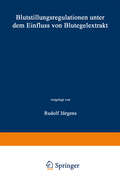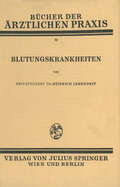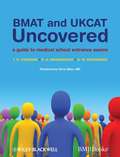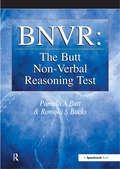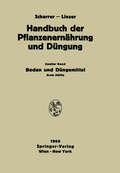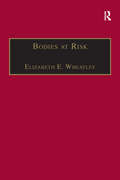- Table View
- List View
Blutkrankheiten (Medizinische Praxis #13 )
by Heinrich SchlechtDieser Buchtitel ist Teil des Digitalisierungsprojekts Springer Book Archives mit Publikationen, die seit den Anfängen des Verlags von 1842 erschienen sind. Der Verlag stellt mit diesem Archiv Quellen für die historische wie auch die disziplingeschichtliche Forschung zur Verfügung, die jeweils im historischen Kontext betrachtet werden müssen. Dieser Titel erschien in der Zeit vor 1945 und wird daher in seiner zeittypischen politisch-ideologischen Ausrichtung vom Verlag nicht beworben.
Blutkrankheiten und Blutdiagnostik
by Otto NaegeliDieser Buchtitel ist Teil des Digitalisierungsprojekts Springer Book Archives mit Publikationen, die seit den Anfängen des Verlags von 1842 erschienen sind. Der Verlag stellt mit diesem Archiv Quellen für die historische wie auch die disziplingeschichtliche Forschung zur Verfügung, die jeweils im historischen Kontext betrachtet werden müssen. Dieser Titel erschien in der Zeit vor 1945 und wird daher in seiner zeittypischen politisch-ideologischen Ausrichtung vom Verlag nicht beworben.
Blutkrankheiten und Blutdiagnostik: Lehrbuch der Klinischen Hämatologie
by Otto NaegeliDieser Buchtitel ist Teil des Digitalisierungsprojekts Springer Book Archives mit Publikationen, die seit den Anfängen des Verlags von 1842 erschienen sind. Der Verlag stellt mit diesem Archiv Quellen für die historische wie auch die disziplingeschichtliche Forschung zur Verfügung, die jeweils im historischen Kontext betrachtet werden müssen. Dieser Titel erschien in der Zeit vor 1945 und wird daher in seiner zeittypischen politisch-ideologischen Ausrichtung vom Verlag nicht beworben.
Blutstillungsregulationen unter dem Einfluss von Blutegelextrakt: Inaugural — Dissertation
by Rudolf JürgensDieser Buchtitel ist Teil des Digitalisierungsprojekts Springer Book Archives mit Publikationen, die seit den Anfängen des Verlags von 1842 erschienen sind. Der Verlag stellt mit diesem Archiv Quellen für die historische wie auch die disziplingeschichtliche Forschung zur Verfügung, die jeweils im historischen Kontext betrachtet werden müssen. Dieser Titel erschien in der Zeit vor 1945 und wird daher in seiner zeittypischen politisch-ideologischen Ausrichtung vom Verlag nicht beworben.
Bluttransfusion und Immunsystem: Grundlagen, Methoden und klinische Anwendung der leukozytenfreien Erythrozytenpräparationen
by P. Höcker N. MüllerBlutungskrankheiten: Band 42
by Heinrich LehndorffDieser Buchtitel ist Teil des Digitalisierungsprojekts Springer Book Archives mit Publikationen, die seit den Anfängen des Verlags von 1842 erschienen sind. Der Verlag stellt mit diesem Archiv Quellen für die historische wie auch die disziplingeschichtliche Forschung zur Verfügung, die jeweils im historischen Kontext betrachtet werden müssen. Dieser Titel erschien in der Zeit vor 1945 und wird daher in seiner zeittypischen politisch-ideologischen Ausrichtung vom Verlag nicht beworben.
Blutzirkulation. 2 Teile. 1926/27 (Handbuch der normalen und pathologischen Physiologie)
by A. BetheDieser Buchtitel ist Teil des Digitalisierungsprojekts Springer Book Archives mit Publikationen, die seit den Anfängen des Verlags von 1842 erschienen sind. Der Verlag stellt mit diesem Archiv Quellen für die historische wie auch die disziplingeschichtliche Forschung zur Verfügung, die jeweils im historischen Kontext betrachtet werden müssen. Dieser Titel erschien in der Zeit vor 1945 und wird daher in seiner zeittypischen politisch-ideologischen Ausrichtung vom Verlag nicht beworben.
BLyS Ligands and Receptors (Contemporary Immunology)
by Michael P. CancroDiscovery of the BLyS (also known as BAFF) family of ligands and receptors has yielded a paradigm shift in our view of B-lymphocyte selection, survival, activation, and homeostasis. Previously, the B-cell antigen receptor (BCR) was viewed as the sole mediator of these parameters, in which BCR signals were not only dominant but were also linearly related to consequent outcomes. However, appreciating that BLyS signaling is an equal partner in establishing and maintaining B-cell pools in- cated that additional regulatory complexity – apparently based on population density and homeostatic demands – had to be included in models of B-cell behavior. This mounting interest was ampli?ed by evidence of a clear relationship to autoim- nity. The resulting ?urry of research activity has yielded a wealth of information and insights, impacting basic concepts in B-cell tolerance and activation as well as revealing novel translational strategies for autoimmunity, neoplasia, and transplant tolerance. This book includes 12 chapters that together yield an overview of these advances and ideas. The initial excitement generated by associations with humoral autoimmunity, coupled with profound B lineage phenotypes in knockout mouse models, prompted immediate questions: What do these receptors and cytokines look like, how do they interact, what cells express them, and how does this inform our understating of their biology? Indeed, probing the structural features of BLyS family ligands and rec- tors has afforded substantial insight, as have studies directed toward understanding the basic biological actions of these molecules.
BMAT and UKCAT Uncovered: A Guide to Medical School Entrance Exams
by T. O. Osinowo R. A. Weerakkody H. W. WoodwardContains over one thousand practice questions - worked examples, quick tests, 2 full BMAT-style sample test papers, and 2 full UKCAT-style sample test papers. With the use of admissions tests becoming an increasingly more common part of the selection process for entrance to medical school, BMAT and UKCAT Uncovered is a comprehensive yet accessible guide to the two main tests used by UK medical schools. Written by recent Cambridge graduates, the authors' experience lies in taking these exams themselves and teaching students how to pass them. They combine key strategies for tackling the specific skills tested by the BioMedical Admissions Test and the UK Clinical Aptitude Test, along with practice questions and tests, with worked answers, in the style of the BMAT and UKCAT exams. The simple, informal teaching style, highlighting key practice areas, with the minimal use of jargon, means BMAT and UKCAT Uncovered is an essential tool for all medical school applicants.
BMAT and UKCAT Uncovered: A Guide to Medical School Entrance Exams
by T. O. Osinowo R. A. Weerakkody H. W. WoodwardContains over one thousand practice questions - worked examples, quick tests, 2 full BMAT-style sample test papers, and 2 full UKCAT-style sample test papers. With the use of admissions tests becoming an increasingly more common part of the selection process for entrance to medical school, BMAT and UKCAT Uncovered is a comprehensive yet accessible guide to the two main tests used by UK medical schools. Written by recent Cambridge graduates, the authors' experience lies in taking these exams themselves and teaching students how to pass them. They combine key strategies for tackling the specific skills tested by the BioMedical Admissions Test and the UK Clinical Aptitude Test, along with practice questions and tests, with worked answers, in the style of the BMAT and UKCAT exams. The simple, informal teaching style, highlighting key practice areas, with the minimal use of jargon, means BMAT and UKCAT Uncovered is an essential tool for all medical school applicants.
BNVR: The Butt Non-Verbal Reasoning Test
by Pamela Butt Romola BucksThe BNVR Test is a unique non-linguistic approach for identifying whether a cognitive (problem-solving) deficit as well as a linguistic deficit exists in individuals with acquired aphasia. Recognising cognitive deficits in terms of problem-solving may be a key factor in understanding why some individuals overcome their communication difficulties better than others. Failure to recognise problem-solving difficulties may lead to unrealistic expectations of therapeutic intervention and thus inappropriate management and goal setting. The BNVR requires the client to solve 10 everyday problems, presented in full-colour photographic format. It is short, requires minimal linguistic input, contains real-life situations and is likely to be suitable for non-English speaking individuals. It will be useful to speech language therapists, occupational therapists and psychologists who need to ascertain whether problem-solving skills are affected and to assist in multi-disciplinary team decision-making in acute and rehabilitation settings.
BNVR: The Butt Non-Verbal Reasoning Test
by Pamela Butt Romola BucksThe BNVR Test is a unique non-linguistic approach for identifying whether a cognitive (problem-solving) deficit as well as a linguistic deficit exists in individuals with acquired aphasia. Recognising cognitive deficits in terms of problem-solving may be a key factor in understanding why some individuals overcome their communication difficulties better than others. Failure to recognise problem-solving difficulties may lead to unrealistic expectations of therapeutic intervention and thus inappropriate management and goal setting. The BNVR requires the client to solve 10 everyday problems, presented in full-colour photographic format. It is short, requires minimal linguistic input, contains real-life situations and is likely to be suitable for non-English speaking individuals. It will be useful to speech language therapists, occupational therapists and psychologists who need to ascertain whether problem-solving skills are affected and to assist in multi-disciplinary team decision-making in acute and rehabilitation settings.
Board Certification in Clinical Neuropsychology: A Guide to Becoming ABPP/ABCN Certified Without Sacrificing Your Sanity (AACN Workshop Series)
by Kira E. Armstrong, PhD, ABPP Dean W. Beebe, PhD, ABPP Robin C. Hilsabeck, PhD, ABPP Michael W. Kirkwood PhD, ABPPPursuit of board certification through the American Board of Professional Psychology (ABPP) has become a standard expectation for clinical neuropsychologists. At the time this book was published, the American Board of Clinical Neuropsychology (ABCN) was the fastest growing specialty board of ABPP with over 1,000 active members. However, the board certification process is challenging and can be intimidating. The objectives of this book are to demystify the process and provide practical advice for achieving board certification through ABPP/ABCN. To start, benefits of board certification are summarized and common myths debunked. Next, individual chapters for each step in the process, as well as a chapter devoted to pursuit of the pediatric subspecialty, provide details about essential elements of the task, the process, the timeline, strategies for success, common pitfalls, and what happens behind the scenes at ABPP/ABCN. Each of these chapters also has tips for trainees and supervisors who want to get a jump on preparing for board certification. Finally, encouragement and guidance for individuals who encounter setbacks at any step along the way are offered.
Board Certification in Clinical Neuropsychology: A Guide to Becoming ABPP/ABCN Certified Without Sacrificing Your Sanity (AACN Workshop Series)
by Kira E. Armstrong, PhD, ABPP Dean W. Beebe, PhD, ABPP Robin C. Hilsabeck, PhD, ABPP Michael W. Kirkwood PhD, ABPPPursuit of board certification through the American Board of Professional Psychology (ABPP) has become a standard expectation for clinical neuropsychologists. At the time this book was published, the American Board of Clinical Neuropsychology (ABCN) was the fastest growing specialty board of ABPP with over 1,000 active members. However, the board certification process is challenging and can be intimidating. The objectives of this book are to demystify the process and provide practical advice for achieving board certification through ABPP/ABCN. To start, benefits of board certification are summarized and common myths debunked. Next, individual chapters for each step in the process, as well as a chapter devoted to pursuit of the pediatric subspecialty, provide details about essential elements of the task, the process, the timeline, strategies for success, common pitfalls, and what happens behind the scenes at ABPP/ABCN. Each of these chapters also has tips for trainees and supervisors who want to get a jump on preparing for board certification. Finally, encouragement and guidance for individuals who encounter setbacks at any step along the way are offered.
Board Stiff TEE E-Book: Transesophageal Echocardiography
by Christopher Gallagher John C Sciarra Steven GinsbergLearn TEE the fun and effortless way! Dr. Gallagher returns with the 2nd edition of Board Stiff TEE: Transesophageal Echocardiography, following the same humorous, digestible writing style that made the last edition a runaway best seller. This highly effective, enjoyable, and affordable medical reference book is not only ideal for those taking the boards; it is also a great overview for anyone looking to stay up-to-date on this increasingly important monitoring modality.Consult this title on your favorite e-reader, conduct rapid searches, and adjust font sizes for optimal readability. Compatible with Kindle®, nook®, and other popular devices.Get a detailed review of all of the PTEeXAM topics listed by the National Board of Echocardiography, written in a digestible, humorous, and engaging style. Understand difficult concepts and problems with the help of 150 schematic drawings. Access comprehensive, problem-solving guidance on quantitative aspects of TEE through a practical appendix that includes gradients, valve areas, and chamber pressures.Master TEE and confidently take the PTEeExam with Board Stiff TEE: Transesophageal Echocardiography!Stay current on the latest advances with a new chapter covering 3D TEE.Search the complete contents online, and access additional exam-type questions and cases, at www.expertconsult.com!
Bobath Concept: Theory and Clinical Practice in Neurological Rehabilitation
by Linzi Meadows Sue Raine Mary Lynch-ElleringtonAuthored by members of the British Bobath Tutors Association, Bobath Concept: Theory and Clinical Practice in Neurological Rehabilitationis a practical illustrated guide that offers a detailed exploration of the theoretical underpinning and clinical interventions of the Bobath Concept. The evolution of the Bobath concept is brilliantly captured in this volume. The recognition that the best inhibition may come from engaging the patient in normal activities is an example of the way one of the notions central to the original Bobath Concept has developed. In short, the Bobath Concept lies at the heart of an approach to neurorehabilitation that is ready to take advantage of the rapidly advancing understanding, coming from neuroscience, of brain function in, in particular, of the effects of and responses to damage, and the factors that may drive recovery. It is no coincidence that neuroplasticity figures so prominently in the pages that follow.’ Emeritus Professor Raymond Tallis BM BCh BA FRCP FMedSci LittD DLitt FRSA This book guides the reader through general principles to more specific application of neurophysiological principles and movement re-education in the recovery of important areas, including moving between sitting and standing, locomotion and recovery of upper limb function. Bobath Concept: Theory and Clinical Practice in Neurological Rehabilitationwill be invaluable to undergraduate and qualified physiotherapists /occupational therapists and all professionals working in neurological rehabilitation. Covers the theoretical underpinning of the Bobath Concept. Presents a holistic, 24-hour approach to functional recovery. Focuses on efficient movement and motor learning, to maximise function. Forges links between theory and clinical practice. Illustrated throughout.
Bobath Concept: Theory and Clinical Practice in Neurological Rehabilitation
by Sue RaineAuthored by members of the British Bobath Tutors Association, Bobath Concept: Theory and Clinical Practice in Neurological Rehabilitationis a practical illustrated guide that offers a detailed exploration of the theoretical underpinning and clinical interventions of the Bobath Concept. The evolution of the Bobath concept is brilliantly captured in this volume. The recognition that the best inhibition may come from engaging the patient in normal activities is an example of the way one of the notions central to the original Bobath Concept has developed. In short, the Bobath Concept lies at the heart of an approach to neurorehabilitation that is ready to take advantage of the rapidly advancing understanding, coming from neuroscience, of brain function in, in particular, of the effects of and responses to damage, and the factors that may drive recovery. It is no coincidence that neuroplasticity figures so prominently in the pages that follow.’ Emeritus Professor Raymond Tallis BM BCh BA FRCP FMedSci LittD DLitt FRSA This book guides the reader through general principles to more specific application of neurophysiological principles and movement re-education in the recovery of important areas, including moving between sitting and standing, locomotion and recovery of upper limb function. Bobath Concept: Theory and Clinical Practice in Neurological Rehabilitationwill be invaluable to undergraduate and qualified physiotherapists /occupational therapists and all professionals working in neurological rehabilitation. Covers the theoretical underpinning of the Bobath Concept. Presents a holistic, 24-hour approach to functional recovery. Focuses on efficient movement and motor learning, to maximise function. Forges links between theory and clinical practice. Illustrated throughout.
Boden und Düngemittel (Handbuch der Pflanzenernährung und Düngung #2 / 2)
by E. Abrahamczik J. M. Herrera H.-J. Altemüller A. Amberger N. Atanasiu J. Baeyens H. Banthien G. Barbier P. Boekel H. Bortels G. Braune M. F. Boodt L. De Leenheer E. Eriksson W. Flaig H. Franz H. Frese A. Fruhstorfer S. Gericke Gertraude Glathe H. Glathe W. Höfner K. Kaindl E. Knickmann H. Koepf J. J. Lehr H. Linser H. Löcker E. Mückenhausen H. Müller D. J. Nicholas T. Niedermaier P. K. Peerlkamp V. Rank K. Rauhe E. Rauterberg G. Riehle J. Chr. Salfeld H. K. Schäfer K. C. Scheel U. Schwertmann H. Söchtig S. Trocmé B. Wohlrab F.-H. ZiemerBodies Across Borders: The Global Circulation of Body Parts, Medical Tourists and Professionals
by Bronwyn Parry Beth Greenhough Isabel DyckHistorically organised at a local or national scale, the fields of medicine and healthcare are being radically transformed by new communication, transport and biotechnologies creating, in the process, a genuinely globalised sphere of biomedical production and consumption. This emerging market is characterised by the circulation of bodily materials (tissues, organs and bio-information), patients and expertise across what traditionally have been relatively secure ontological and geographical borders. Crossing both disciplinary and geographical boundaries, this volume draws together a number of important contributions from acknowledged leaders in three respective fields: the trade in bodily commodities, biomedical tourism and migration of health care professionals. It explores and maps out the key characteristics of this emerging, although as yet poorly researched global trade, questioning how, where and why bodies cross borders, whether this exacerbates existing health inequalities and how these circulations impact on healthcare services. Considered together, the chapters in this volume invite comparisons of the ways in which body parts, patients and medical professionals cross national borders, elucidating common themes, concerns and issues. Contributors also pose important questions about the ethical and legal implications of the circulation of bodies across borders and evaluate current and future strategies for regulation.
Bodies Across Borders: The Global Circulation of Body Parts, Medical Tourists and Professionals
by Bronwyn Parry Beth Greenhough Isabel DyckHistorically organised at a local or national scale, the fields of medicine and healthcare are being radically transformed by new communication, transport and biotechnologies creating, in the process, a genuinely globalised sphere of biomedical production and consumption. This emerging market is characterised by the circulation of bodily materials (tissues, organs and bio-information), patients and expertise across what traditionally have been relatively secure ontological and geographical borders. Crossing both disciplinary and geographical boundaries, this volume draws together a number of important contributions from acknowledged leaders in three respective fields: the trade in bodily commodities, biomedical tourism and migration of health care professionals. It explores and maps out the key characteristics of this emerging, although as yet poorly researched global trade, questioning how, where and why bodies cross borders, whether this exacerbates existing health inequalities and how these circulations impact on healthcare services. Considered together, the chapters in this volume invite comparisons of the ways in which body parts, patients and medical professionals cross national borders, elucidating common themes, concerns and issues. Contributors also pose important questions about the ethical and legal implications of the circulation of bodies across borders and evaluate current and future strategies for regulation.
Bodies and Suffering: Emotions and Relations of Care (Routledge Advances in the Medical Humanities)
by Ana Dragojlovic Alex BroomThis book is a critical response to a range of problems – some theoretical, others empirical – that shape questions surrounding the lived experience of suffering. It explores how moral and ethical questions of personal suffering are experienced, contested, negotiated and institutionalised. Bodies and Suffering investigates the moral labour and significance invested in actions to care for others, or in failing to do so. It also explores circumstances – personal, political and social – under which that which is perceived as non-moral becomes moral. Drawing on case studies and empirical research, Bodies and Suffering examines the idea of the suffering body across different cultures and contexts and the experience and treatment of these suffering bodies. The book draws on theories of affect, embodiment, the phenomenology of illness and moralities of care, to produce a nuanced understanding of suffering as being located across the assumed borders of time, space, bodies, persons and things. Suitable for bioethicists, medical anthropologists, health sociologists and body studies scholars, Bodies and Suffering will also be of use on health science courses as essential reading on suffering bodies, mental health and morality and ethics issues.
Bodies and Suffering: Emotions and Relations of Care (Routledge Advances in the Medical Humanities)
by Ana Dragojlovic Alex BroomThis book is a critical response to a range of problems – some theoretical, others empirical – that shape questions surrounding the lived experience of suffering. It explores how moral and ethical questions of personal suffering are experienced, contested, negotiated and institutionalised. Bodies and Suffering investigates the moral labour and significance invested in actions to care for others, or in failing to do so. It also explores circumstances – personal, political and social – under which that which is perceived as non-moral becomes moral. Drawing on case studies and empirical research, Bodies and Suffering examines the idea of the suffering body across different cultures and contexts and the experience and treatment of these suffering bodies. The book draws on theories of affect, embodiment, the phenomenology of illness and moralities of care, to produce a nuanced understanding of suffering as being located across the assumed borders of time, space, bodies, persons and things. Suitable for bioethicists, medical anthropologists, health sociologists and body studies scholars, Bodies and Suffering will also be of use on health science courses as essential reading on suffering bodies, mental health and morality and ethics issues.
Bodies at Risk: An Ethnography of Heart Disease
by Elizabeth E. WheatleyIn Bodies at Risk, Elizabeth Wheatley provides a fascinating ethnography of heart disease. She looks at what happens to someone after a heart attack and how they get on with 'business as usual' in the wake of a potentially fatal medical crisis. How are daily routines, personal identities, families, friends, and careers affected and rearranged after diagnosis and treatment? This book examines the unfinished business of having and handling heart disease. The research is based on one-on-one and collective interviews, focus groups and participant observation in hospitals, cardiac rehabilitation clinics, and in people's homes. As heart disease is one of the major causes of death in the western world, this book is both timely and important. It is inspired by and contributes to sociological writing on the body, risk, experiences of illness, and medicalization, and will appeal to academics and students in these areas as well as in cultural studies, health-related consumption, health promotion and qualitative health research.
Bodies at Risk: An Ethnography of Heart Disease
by Elizabeth E. WheatleyIn Bodies at Risk, Elizabeth Wheatley provides a fascinating ethnography of heart disease. She looks at what happens to someone after a heart attack and how they get on with 'business as usual' in the wake of a potentially fatal medical crisis. How are daily routines, personal identities, families, friends, and careers affected and rearranged after diagnosis and treatment? This book examines the unfinished business of having and handling heart disease. The research is based on one-on-one and collective interviews, focus groups and participant observation in hospitals, cardiac rehabilitation clinics, and in people's homes. As heart disease is one of the major causes of death in the western world, this book is both timely and important. It is inspired by and contributes to sociological writing on the body, risk, experiences of illness, and medicalization, and will appeal to academics and students in these areas as well as in cultural studies, health-related consumption, health promotion and qualitative health research.




